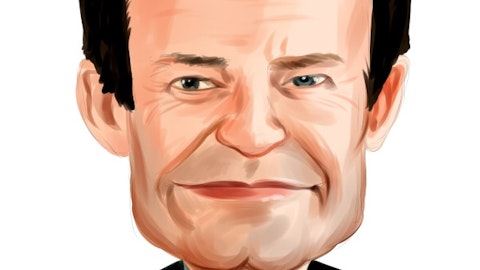Michael Hurlston: Yes. I think you actually got it right. We’re forecasting the PC market to be down sort of high-single digits. So that’s the biggest contributor. The other areas are coming back a bit. I mean, I think you’ve got it right, that’s a couple of percent. So I think we’re at the bottom. I think we’re still trying to figure out when we see increases in that business. And I think it is tied, as Dean said, to the enterprise IT spending. But we feel pretty good, I think, for the second quarter in a row about declaring absolute bottom, and numbers are starting to reflect that.
Kaykin Peng: And then, for — just kind of on Chris’ comment on the snapback and the Core IoT [indiscernible] wireless portion, that was a $200 million revenue run rate kind of business. Do you think that you can kind of get back to those levels some time in this calendar year? Or is this more of a first half 2025 calendar year kind of trajectory?
Michael Hurlston: Yes. Look, we feel very good about it. I think that the line of sight to getting back to par here is much closer. I don’t think we have necessarily perfect visibility on the timing, but we feel very good that that’s closer in than some of these other things in terms of the inventory levels. And then again, we are expecting to layer design wins on top of that. So our wireless business feels very good. Our confidence is generally very high.
Kaykin Peng: Thank you, guys.
Operator: Thank you. One moment for questions. Our next question comes from Krish Sankar with TD Cowan. You may proceed.
Krish Sankar: Hi. Thanks for taking my question. I have two of them. Michael, just on the last question and your answer, it looks like you’re guiding the wireless Core IoT growing 20% sequentially. And I’m not looking for guidance, but is it fair to assume that kind of a growth rate is sustainable through the remaining quarters this year?
Michael Hurlston: Again, we feel pretty good about the business. And I would say, certainly, we’re going to see double digits sequentially from here quarter-over-quarter. So I think we feel really, really good about where that business is. We’re really just trying to get it back, as I think the previous questioner asked, to the $200 million level, and we think that that’s relatively close in, and then growth from there. So I think it’s fair for us to say that this level or somewhere in the kind of the double digits sequentially is very, very possible over the next few quarters.
Krish Sankar: Got it. And then, a follow-up for Dean. When I look at your March quarter guidance, you guys kind of gave the product mix. And it looks like 3/4 of your products are more — should be in the high 50% gross margin range, if you’re guiding more to like 52% to 54%. So I’m kind of curious. I understand enterprise and auto has still inventory. But what are like the one or two biggest overhang on the gross margin side now? Is it volume? Is it foundry pricing? Any color on that would be helpful.
Dean Butler: Yes. There’s obviously many variables in that, Krish. There’s absorption at current revenue levels. There’s always some prices improving on the supply side. There’s some actually going the opposite way. But more than any of that actually happens to be the product mix. Generally, our enterprise bucket tends to have a higher gross margin mix of its own products, even sort of within products. And I think Michael sort of touched on it a little bit in his prepared remarks. Some of our sort of best gross margin applications that go into like docking stations or high-end audio headsets are seeing some of the most sort of hesitation from corporate IT buying. And so, that sort of contributed on to where we are on the margin mix. However, we’re starting to see upside into IoT. And as Core IoT grows, that is actually also helpful [indiscernible] everything else moving around.
Krish Sankar: Got it. Thanks a lot Dean.
Dean Butler: Yes. No problem, Krish.
Operator: Thank you. One moment for questions. Our next question come from Gary Mobley with Wells Fargo. You may proceed.
Gary Mobley: Hi, guys. Thanks for taking my question. If I’m hearing you guys correctly, it sounds like perhaps structurally, the market size or revenue potential in enterprise might be a little bit smaller than what you were thinking at your Analyst Day. At least the minimum pushed out further to the right. And therefore, the question is, is that causing you to sort of reevaluate the long-term gross margin target of 57%, which I believe is highly contingent on that very healthy margin mix from enterprise?
Michael Hurlston: Yes, Gary, I think you got one phrase of the question right in that, we see it as a push-out, nothing more. So I think that we feel good about the market sizes for our enterprise business. I think that we certainly realize that behind some of the inventory, there is a current depressed demand environment due to the enterprise IT spending. But we actually don’t substantively believe that the demand profile in those long term has changed, right? We’ve actually gone out in a huge way to the enterprise customers to sort of assess and feel out, hey, what is the long-term demand in these businesses? And that has not changed. So everybody is still bullish about docking station consumption, enterprise telephony. In fact, we’ve got a bunch of new refreshes coming on both of those areas, both in dock and enterprise telephony, that will be kicking in, in the second half of this year, and enterprise headsets.
So all three of those segments, which are definitely pronounced down due to the enterprise IT spending, big drivers of our margin line. I don’t think that there’s any change. Dean, you can correct me if I’m wrong, in sort of our view of the overall markets.
Dean Butler: No. Yes, I don’t think there’s a market destruction, if that’s what you’re sort of going for, Gary. The second part of your question was dependence on that enterprise mix to drive 57%, which is the long-term target for the company on gross margin. We are dependent on enterprise actually performing well and coming back to a more normal level. I think what you will see is we’re going to continue to be dependent on it. And that means the timing to achieve 57% is probably a little bit longer and really is predicated on the enterprise spending sort of coming back.
Gary Mobley: Got it. Thank you guys for that. Dean, you underspent on the OpEx side in the December quarter by roughly 6%. Sounded like that was more variable versus structural in terms of OpEx reduction. Correct me if I’m wrong there, but I’m most curious about how we should model and think about the OpEx when revenue normalizes, when you actually start to ship in aggregate to end demand, let’s call it, $300 million per quarter plus in revenue.
Dean Butler: Yes. So first On the December quarter, you picked up exactly right, Gary. It was under our guidance and actually under the prior quarter, really from a one-time on variable expense. We’re guiding into the March quarter that that doesn’t reoccur, it sort of goes back to where sort of run rate spend level is. As you know, our committed level on operating expenses has been $100 million a quarter or below and we’ve done a pretty good job to sort of keep it maintained inside that range. Now if you start to think about, hey, what does the company look like at a higher revenue base? We do anticipate that we would likely need to spend a bit more than that from here, But I wouldn’t say that it’s monumentally more. The way I think about it, Gary, it’s probably something like a 5% adder on operating expense, kind of this mid, maybe high single digits that we would likely go up as revenue comes in.
I mean, you will see in the beginning of our fiscal year, every year, there’s sort of a little bit of resets on variable comp, the merit cycles, et cetera. Just a reminder, we’re a junior end, so that’s kind of starts to hit in the September quarter for us. So, I hope that helps, Gary.
Gary Mobley: It does. Thank you.
Operator: Thank you. One moment for questions. Our next question comes from Vijay Rakesh with Mizuho. You may proceed.
Vijay Rakesh: Yes. Hi, Michael and Dean. Good to hear businesses bottom. So I’m just wondering, just looking at the rest of 2024, just wondering how the seasonality plays out for you through 2024. Do you expect to get back to kind of that $300 million level exiting the year or something?
Michael Hurlston: Yes, Vijay, good question. The one thing I would say is, kind of calendar 2024, it’s really tough for us to tell like what is going to happen from here. Look we’re sort of bottom, we’re coming up, Core IoT is growing nicely. However PC and mobile type applications are very seasonal. I think actually industry-wide people are trying to get a handle on, hey, how did the sequential sort of move from here? I think the most comfort I have is, we’re likely to move higher. We’re almost unlikely to go lower. So it’s higher and I think you’d see more sequential growth sort of continually led by core IoT. Enterprise is less clear for us. It’s just tough for us to confirm, Vijay, on exactly seasonality and what that pattern will look like. Core IoT right now is what we probably have the most confidence behind.




